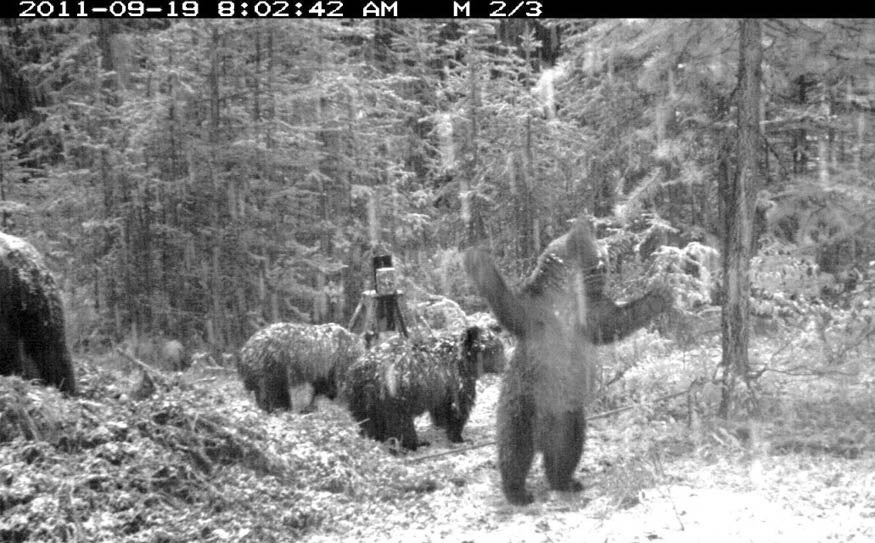The cameras are rolling all the time.
They capture a mother teaching her kids what to eat, how to safely navigate their neighbourhood. Her every moment is recorded — swinging on a rope to splash into Johnson Lake on a hot summer day, encountering tourists on a hiking trail.
The cameras however, are not trained on the latest reality TV mom, but on a grizzly bear in the Canadian Rockies.
Produced by the National Film Board of Canada (NFB), Bear 71 is an interactive documentary created by a team of designers and digital technicians developed from the idea of Canmore filmmaker, Leanne Allison.
The result of a large collaborative process, the 20-minute film incorporates a digital landscape map with still and video images captured by sensor-triggered cameras installed on backcountry trails. Navigating by keyboard or mouse, the viewer passes over lakes, forest, rivers, the railroad and highway encountering wolves, bears, cougars, deer, ravens and wolverines. Pullout segments share individual animals' stories — the name researchers gave it, distances travelled, young raised, highway crossings via over or underpasses. The viewer can become part of the picture, literally, via their own desktop camera.
Allison's last film, Finding Farley, captured how she, husband, Karsten Heuer, and toddler son, Zev, crossed Canada mostly by canoe. Her first, Being Caribou, recounted how she and Heuer followed a caribou herd on foot for five months and 1,500 kilometres across arctic tundra. The film earned a Gemini; the experience altered the couple's view of life.
Through Heuer's work as a Parks Canada wildlife biologist, Allison knew of thousands of hours of wildlife footage captured on remote trail cameras. After obtaining permission from the researchers maintaining them, including Parks Canada, Alberta Provincial Parks, and Montana State University, she spent months sifting through low-res images.
"I've always been intrigued by the trail cam photos," Allison said. "Once I had the opportunity to actually look at huge numbers of those photos, it made me see this massive landscape in a totally different way. It's like nature uninterrupted."
While she felt she'd recaptured some of the connection to nature she and Heuer experienced during their Being Caribou adventure, Bear 71 emerged as a natural star.
"So much is known about Bear 71," Allison said. "She was collared when she was three and has been watched every day of her life since. I realized we could tell a detailed and rich story about this bear's life."
Written by award winning author JB MacKinnon and narrated by actor Mia Kirshner, Bear 71 expresses a wry sense of humour and social awareness through 11 separate scenes.
"It's a minefield out there," says the bear. "They can start a revolution on a smartphone, but they can't remember to close the lid on a bear-proof bin."
While Allison pitched the idea to the NFB as a traditional documentary, co-creator Jeremy Mendes realized the images encompassed the bigger picture of how people live in the modern age of social networks and iPhones.
"The story is not so much that like the Bear, we too as humans are under a constant state of surveillance by cameras on street corners and bank machines," explained co-executive producer Rob McLaughlin. "The story is more about how today we truly manage and understand almost all of our relationships — human or otherwise — through an expanding and evolving range of data and technologies, including cameras."
Case in point — the team created the project specifically to fit the parameters of the NFB's interactive documentary format.
"The map represents the world of data as we see it — a world where we study and classify things in data visualizations," said co-executive producer Loc Dao. "We chose to make the map a time-lapsed world that was inspired by the Bow Valley, but could really be anywhere."
While it may seem ironic to create a largely digital project to highlight the natural world, at the same time technology can be a useful means of expanding awareness of the outdoor world. At the January premiere of Bear 71 at Sundance Film Festival in Park City, Utah, the filmmakers incorporated an eight-metre projection screen and iPad tablets to allow audience members to navigate the bear's world. Allison also set up a culvert trap and rub tree complete with claw scratching and fur tufts.
While the facts of Bear 71's life, which ended on the railroad tracks after "11 years of doing everything right", are rife with unsettling statistics about the effects of human encroachment on mountain wilderness, Allison said she prefers to focus on the positive work that's being done to help wildlife flourish.
"It's not a good guys/bad guys story, it's a complex issue," Allison said. "I think the highway mitigation structures are an incredible success story. Now we need to put the same kinds of resources towards railway issues."
On some level, Dao said he hoped people might realize the consequences of their actions.
"Hopefully the film will make people empathize with wildlife," Allison added. "I hope it makes people feel what I feel — to shut down their computer and go outside, and maybe look at their world through different eyes."
To see Bear 71 visit this web page: http://bear71.nfb.ca.




